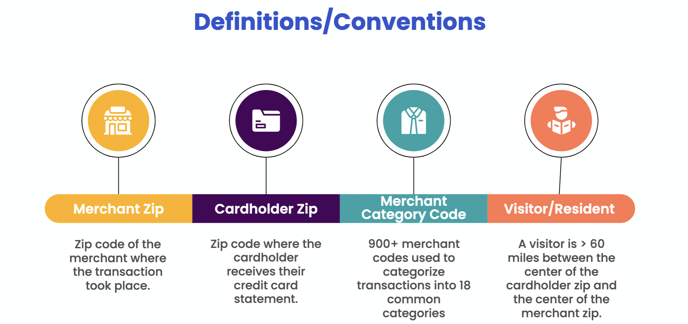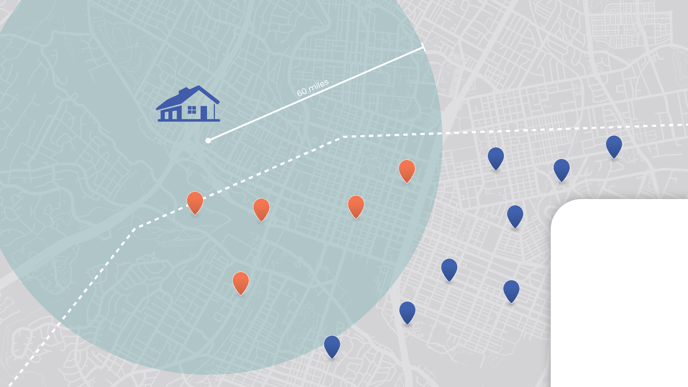We have credit and debit card transaction data that can help you understand where your visitors are spending money in your destination.
What is this data on visitor spending and where does it come from?
Zartico provides high-frequency and high-resolution data to give you the clearest view of your visitor economy. Our spending data contains both credit and debit and a mix of various types of cards, including Visa, Mastercard, and some American Express and Discover. The transactions that are provided include the detailed granularity of the zip codes for both the merchant and the cardholder making the purchase. This sampling of transactions provides glimpses into how your visitors are spending that you can use to make informed decisions regarding your destination. You will also gain information on the breakdown of tourism-related spending categories, and how your visitors are spending their money in your destination.
Find out more about Zartico's licensed data sets by exploring information on our operating system and integrated data model.
Watch this video to learn more about the power and reliability of the spending data available to you in ZDOS®. Spending data in ZDOS® is the same data the National Retail Federation uses to track spending trends. They are highly concerned about the truth about market spending truths and so are we!
Helpful definitions
In order to better understand this data, you can remember that the merchant zip code is the zip code of the merchant where the transaction took place, such as a store. The cardholder zip is the zip code where the cardholder receives their credit card statement, likely their residence. In order to make sure that the data we're providing is from visitors, we filter out resident spending, which is defined as those cardholders whose mailing zip code is within 60 miles of the zip code of the merchant they are purchasing from. The merchant category codes (or MCC codes) from these transactions are categorized into 18 common categories of transactions.

Frequently Asked Questions Regarding Visitor Spending Data
Q: Does the spending data include all types?
A: The spending data we receive includes domestic cardholders and transactions for both credit and debit cards and includes all card types. However, only a portion of American Express transactions are observed because American Express is a direct issuer of credit cards. We are only able to capture the American Express credit card data for those cards issued through financial institutions.
Q: Is the Visitor Spending Included in the Platform Total Spending?
A: The visitor spending volume we receive represents a sample size of the total transaction volume. Your destination's share of this volume could vary based on the financial institutions aggregating this data stream. However, this is a statistically significant volume to draw trends and insights from.
Q: Is Historical Visitor Spending Included in the Operating System?
A: Historical visitor spending data is in the ZDOS® back to January 2021 data to align with our geolocation data.
Q: How is a Visitor Determined in Regard to Spending Data?
A: Within our spending data, we do not have a home location for the cardholders as we do with geolocation data. The merchant location within the credit/debit card dataset is only specified to the zip-code level, so we expanded the definition of Visitor as a transaction greater than 60 miles between the center of the cardholder zip and the center of the merchant zip. This is designed to be consistent with our geolocation visitor definition of a 50-mile radius from home & work location.

Q: Does this data reflect domestic and international spending data?
A: Currently, the visitor spending data we have is for US cardholders and US credit/debit card spending only. We recommend VisaVue for international spending at this time.
Q: What does the transaction date refer to?
A: The daily spend data is the date the transaction took place, not the day the data was processed.
Q: How often do we receive visitor spending data?
A: This data is provided to us on a weekly basis with daily granularity.
Q: Does this spending data show transactions that take place outside of my destination?
A: Our data only includes transactions that took place within the destination.
Q: When Zartico receives data each Monday, do we load just that new data? Or do we do a complete replacement of all historical data?
A: Only the previous week is replaced due to how financial institutions report their transactions and how Zartico collects and cleans data. This is also part of the normalization process.
Q: What does spending data show me about my visitor demographics?
A: Through the Zartico spending you have access to demographic data on your visitors, such as age ranges and income levels. This information comes from the financial providers that pass along anonymized data to our spending data source.
Q: If one person uses multiple credit cards, will they be linked to that one individual?
A: Short answer is no, due to privacy laws, we cannot know the personally identifiable information that would be needed to link multiple credit cards to one person.
Spend data consists of anonymized swipes. Other than where the swipe was made and where the home zip code of the cardholder is, we can’t dive further into this info for technical and regulatory reasons.
Q: Why are there missing ZIP codes in my spending data?
A: The visitor spending data we bring in includes a huge amount of data— 10 billion transactions a year of credit and debit transactions! We process this raw data and organize it for you so that it can be displayed in a way that gives you the clearest view of the visitor economy. Among this huge amount of transaction information, there are times when a transaction is sometimes missing a ZIP code. When this happens, the processing of our data provider has done its best to determine the location, based on other location tags, and will assign a ZIP code affiliated with that location. If that location (city or state) has more than one ZIP code associated with it, the system will randomly choose one to assign. This does result in sometimes misattributing the spending data to other ZIP codes within your destination and/or missing ZIP codes, an issue that is in the process of being improved by our data provider.
Q: What is average visitor spend mean and why does it change when I change the date filter?
A: The math for average visitor spend is total spend / total cardholders. If you are looking at three days and one cardholder spends across all three days, the average cardholder spend goes up because the visitor spend goes up, while the cardholder count stays the same.
In theory... I am in New York for 4 days- November 30 - December 1 (spanning 2 months). I spend $250 a day, or $1000 during the trip
-
If you look at my cardholder spend on a daily basis it is $250
-
If you look at the cardholder spend by month it is $500
-
If you look at the average cardholder spend for the year it is $1,000
Basically, any time you see a smaller time frame, the average visitor spend is going to go down.
To take it one step further:
If 10 different people each day spend $10 each, that's a $10 avg daily spend by visitors, but in a 30-day month those 10 people continue to spend $10 per day, which is $300 average spend for the month. So when looking at a larger time period the average will fluctuate as new cards are swiped in market - it's not that everyone spends $10 per day.
We're so excited about this data, and the insights it can provide you with. Take a look for yourself within the OS, and let us know what you think!
Need more help? Contact us here.